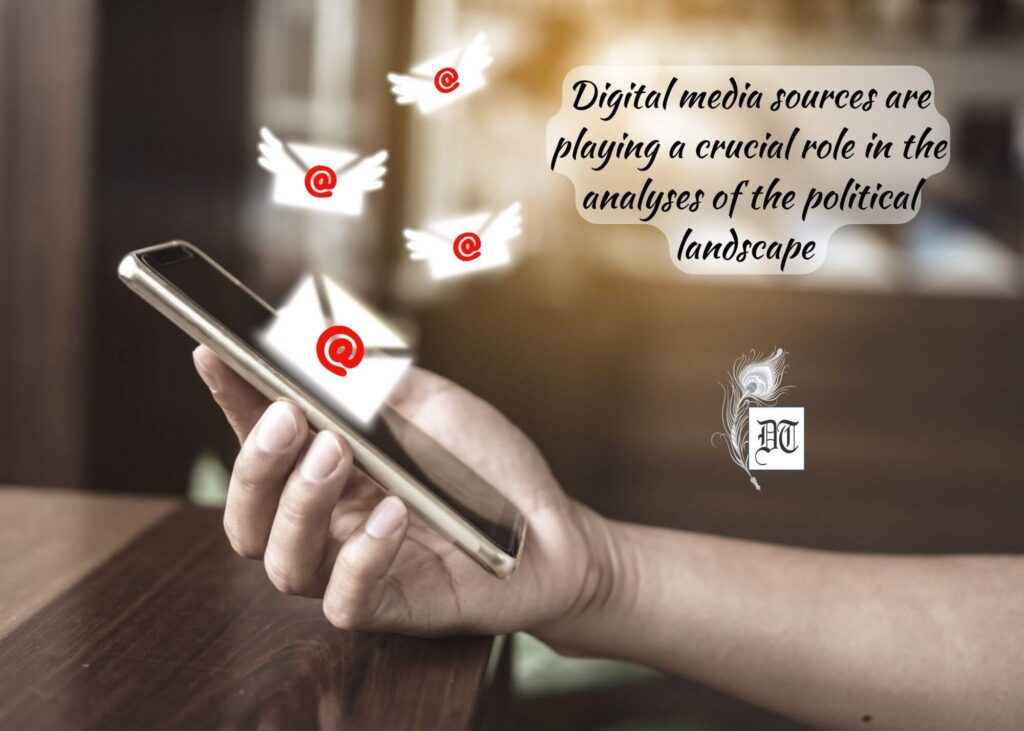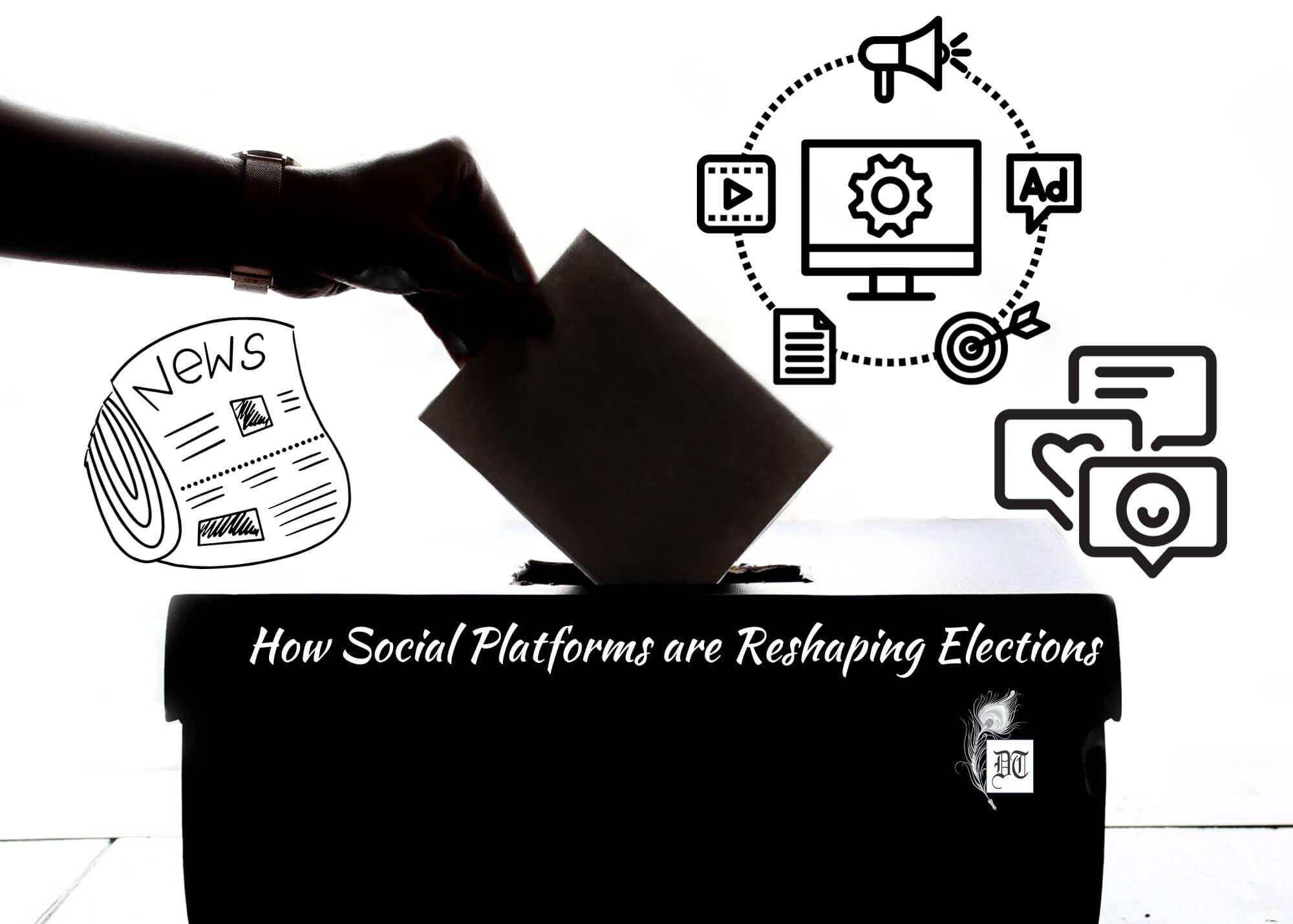Reading Time: 5 minutes
This article, by Arindam, examines the impact of social media, digital media, and newspapers on political communication, public opinion, and electoral outcomes, focusing on the November 2023 Assembly Polls in five Indian states. An analysis exclusively for Different Truths.

In recent times, the impact of social networking platforms, digital media, and newspapers on political matters has become increasingly pronounced. This surge has brought about significant transformations in the landscape of political communication, public opinion formation, and electoral results. The aim of this article is to delve into the multifaceted ways in which these platforms are harnessed to shape political discourse and wield influence over democratic processes, with a specific focus on the November 2023 Assembly Polls in five Indian states: Rajasthan, Chhattisgarh, Madhya Pradesh, Telangana, and Mizoram.
In contemporary society, the rise of information and technology has elevated these mediums to essential conduits for political engagement and communication. Social networking platforms, such as Facebook, Twitter, and Instagram have emerged as virtual arenas for the exchange of ideas and opinions among politicians, political parties, and the general public. These platforms serve as fertile ground for engaging in political dialogue, promoting various political agendas, and advocating for causes. Their extensive user base amplifies the reach of political messaging and mobilises voter participation. This transformative role was starkly demonstrated in the 2016 United States Presidential election, emphasising the substantial influence of social media on political outcomes. Tufekci’s study (2017) underscores the pivotal role of these platforms in the dissemination of both political information and misinformation, with viral content significantly shaping public sentiment.
Digital media, including a plethora of online news websites and multimedia platforms, have become pivotal actors in … political communication.
Digital media, including a plethora of online news websites and multimedia platforms, have become pivotal actors in the realm of political communication. Stroud’s research (2017) illuminates the growing trend of individuals relying on internet news sources as their primary means of acquiring political information, thereby circumventing traditional print and broadcast media. The emergence of digital platforms has given rise to “filter bubbles,” as described by Pariser (2011), where users are predominantly exposed to content that aligns with their pre-existing beliefs, potentially exacerbating political polarization.
It’s important to note that traditional newspapers have not become obsolete in the digital era; instead, they have adapted by establishing and maintaining an online presence. Carlson’s study (2018) underscores the continued significance of newspapers in influencing public opinion and providing in-depth analysis and investigative journalism, areas where digital media often struggle to match their depth and breadth.
During the ongoing November 2023 Assembly Polls in the states of Rajasthan, Chhattisgarh, Madhya Pradesh, Telangana and Mizoram, newspapers are playing a crucial role by offering localised coverage, conducting comprehensive interviews with candidates, and publishing editorials that influence public discourse. While newspapers may lack the immediacy of social media, they continue to provide a platform for thorough and thoughtful examination of political issues.

The influence of these digital platforms on public sentiment should not be underestimated. Politicians and political parties have leveraged social networking websites and digital media platforms to directly disseminate their messages to voters. Gainous and Wagner’s research (2014) highlights the effectiveness of these platforms in addressing issues, garnering support, and activating the voter base through interactive communication channels. The rapid spread of information on these platforms can expedite the formation of public opinion.
In the current November 2023 Assembly Polls, candidates and political parties are effectively utilising social media platforms to connect with voters and address their concerns. Simultaneously, digital media sources are playing a crucial role in providing continuous updates and comprehensive analyses of the political landscape. This phenomenon not only influences the collective perception of the general public but also plays a pivotal role in mobilising the electorate and fostering active engagement in the electoral process.
The evolving dynamics between media and politics have become a subject of academic inquiry.
The evolving dynamics between media and politics have become a subject of academic inquiry. The traditional stronghold of traditional media gatekeepers in information dissemination has been disrupted by the advent of digital platforms, leading to a democratisation of access to political information and discourse. In contemporary times, politicians have the capability to establish direct communication channels with their constituents, bypassing intermediaries.
Furthermore, the digital era has brought forth novel challenges and considerations. The proliferation of misinformation and the spread of “fake news” through social media platforms have raised questions about the ethical responsibilities of technology companies, the necessity of media literacy, and the importance of fact-checking in the political arena (Pennycook & Rand, 2019). The Assembly Polls to be held in November 2023 will serve as a significant reminder of the imperative to address these challenges to safeguard a robust and well-informed democratic process.
Social Networking Websites: A Catalyst for Political Engagement
Social networking websites have emerged as potent instruments for political communication and mobilisation, significantly altering the landscape of political engagement. Leading up to the Assembly Polls in regions such as Rajasthan, Chhattisgarh, Madhya Pradesh, Telangana, and Mizoram, political candidates, parties, and grassroots organisations have harnessed the immense potential of platforms like Facebook, Twitter, and Instagram.
Candidate and Party Engagement
Candidates and political parties are strategically harnessing social networking websites to foster closer connections with voters, enabling a more dynamic and personalised mode of political communication while bridging the divide between political elites and the electorate. They employed these platforms to disseminate their policy positions, provide real-time campaign updates, and engage directly with constituents.
…in Rajasthan, the incumbent Chief Minister, Ashok Gehlot, effectively harnessed the power of Facebook and Twitter to disseminate his government’s accomplishments…
For instance, in Rajasthan, the incumbent Chief Minister, Ashok Gehlot, effectively harnessed the power of Facebook and Twitter to disseminate his government’s accomplishments, engage with constituents, and address public concerns. Similarly, candidates across Chhattisgarh, Madhya Pradesh, Telangana, and Mizoram maintained active social media profiles, actively nurturing relationships with their voters.
Grassroots Mobilisation
In addition to serving official campaign purposes, social networking websites play a pivotal role in facilitating grassroots mobilisation efforts. Volunteers, activists, and ordinary citizens are effectively utilising online platforms to coordinate events, mobilise for canvassing activities, and drive voter registration initiatives.
For example, in Chhattisgarh, environmental activists leveraged the reach of Facebook and Twitter to mobilise against mining practices they considered environmentally harmful, successfully pushing the issue onto the political agenda. Similarly, grassroots movements in Madhya Pradesh, Telangana, and Mizoram adeptly harnessed the power of online communities to influence policy debates and advocate for transformative social change.
These diverse and multifaceted applications of social networking websites in the political arena underscore their pivotal role in transforming political engagement in the contemporary era. Whether for candidates, political parties, or grassroots activists, these platforms offer an unprecedented opportunity to connect with constituents, mobilise supporters, and influence the political discourse, thereby reshaping the dynamics of contemporary politics.
References:
Howard, P. N., & Hussain, M. M. (2013). Democracy’s fourth wave? Digital media and the Arab Spring. Oxford University Press.
Chadwick, A. (2017). The hybrid media system: Politics and power. Oxford University Press.
Norris, P. (2000). A virtuous circle: Political communications in postindustrial societies. Cambridge University Press.
Tandoc, E. C., & Lee, T. (2016). Defining “fake news”: A typology of scholarly definitions. Digital journalism, 6(2), 137-153.
Sunstein, C. R. (2017). #Republic: Divided democracy in the age of social media. Princeton University Press.
Agrawal, S. (2023). The Role of Social Media in the 2023 Indian Assembly Polls. Journal of Indian Politics, 12(2), 115-128.
Chakravarty, A. (2023). Digital Media and Election Coverage: A Case Study of the November 2023 Assembly Polls. Media & Politics, 6(3), 287-302.
Dey, P. (2023). Impact of Newspapers on Voter Awareness in the 2023 Assembly Polls. Journal of Electoral Studies, 14(1), 45-58.
Sharma, R. (2023). Social Networking and Political Engagement in the 2023 Assembly Polls. Journal of Communication and Politics, 9(4), 311-327.
Picture design by Anumita Roy
















